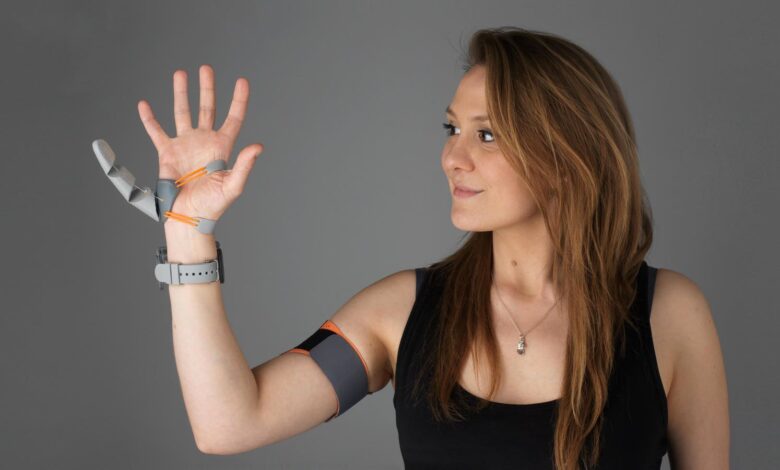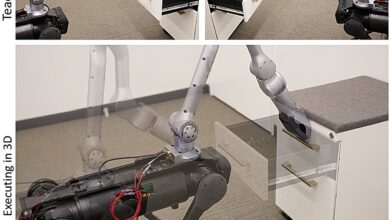Robotic ‘Third Thumb’ Set To Supercharge Your Productivity

Product designer Dani Clode and the Third Thumb she created to boost hand productivity.
If you’ve ever struggled through the door laden with too many packages and wishing you had another set of hands, good news. Innovators out of Cambridge University in the U.K. have developed a controllable robotic extra thumb designed to boost the hand’s functioning.
It does that by increasing range of movement and enhancing grasping and carrying capacity—picture holding a phone in your hand while a bag dangles from the extra thumb as if the mechanical digit were a hook.
The “Third Thumb” straps to the palm, opposite the user’s natural thumb, and has two degrees of freedom. It’s powered by wrist-worn motors, and the wearer controls its movements, and the speed of them, using a pressure sensor placed under each big toe. Pressure exerted on one toe pulls the thumb across the hand, while pressure on the other toe moves the 3D-printed digit up toward the fingers.
It all sounds a bit complicated to maneuver, but researchers say adjusting to the wearable thumb is surprisingly quick and easy. In a new study published in the journal Science Robotics, they detail what happened when they tested the device on a diverse group of subjects from toddlers to nonagenarians. Spoiler alert: Of 596 volunteers, 98% were able to successfully wear, operate and perform a task with the Third Thumb, which is made from a range of plastics, both rigid and flexible.
The thumb’s creator, British product designer Dani Clode, envisions the Third Thumb as a tool for people with disabilities such as paralysis or differences in their upper limbs, or those with reduced physical functioning due to conditions like broken arms or strokes. The robotic finger could also prove useful, she says, for workers required to juggle multiple devices—surgeons or dental hygienists, for example, or assembly line laborers, or even anyone who likes the idea of a supercharged hand.
A Handy And Versatile Invention
“The thumb is the single most useful piece of augmentation technology I’ve personally seen, and this is because it is so easy to control, and because it is so versatile,” Tamar Makin, a professor of cognitive neuroscience at Cambridge University, said in an email interview. Makin runs a lab that studies brain plasticity and co-authored the newly published paper. A former study of the robotic thumb explored how our brains adapt to control an extra body part.
“We are running a lot of basic research to better understand the fundamental principles that make wearable technologies easy to control, and as importantly, to ensure their safety on a cognitive but also neural level,” Makin said.
An extra thumb could make it easier to thread a needle.
The Third Thumb is one of a growing number of augmentative technologies, such as robotic exoskeletons, that are restoring lost physical function and generally pushing the limits of what it means to be human.
“From a design perspective, augmentation is about designing a new relationship with technology, creating something that is no longer just a tool for the hand, but instead an extension of the hand,” designer Clode said in an email interview.
Clode created a first prototype of the thumb while a master’s candidate at London’s Royal College of Art, then began collaborating with Makin and other neurosicentists in the professor’s plasticity lab. Clode designs upper-limb prosthetics, and wanted to better understand the mechanics of the human thumb.
“It’s such an incredibly unique limb and such a challenging, and sometimes left behind, part of a prosthetic hand design,” Clode said.
As the new study details, the Third Thumb team tested the device on visitors to the 2022 Royal Society Summer Science Exhibition, where boffins display their research. They gave volunteers a minute to familiarize themselves with the Third Thumb, then instructed them to complete tasks involving moving pegs or foam objects. You can get a glimpse of those experiments in the video above.
“We showed that pretty much anyone who wants to use the thumb can, and can figure out how to use it very quickly,” Clode said. “This level of evidence goes a long way toward commercialization, but we are not quite there yet.”
In the meantime, the designer is feeling optimistic about the Third Thumb’s potential as a tool that’s both handy and enjoyable to use.
In longer, more in-depth prototype trials lasting five to seven days, Clode was surprised to observe people becoming attached to the finger. “Some of our participants,” she said, “needed a little bit of time to say goodbye to the thumb at the end of the week.”



